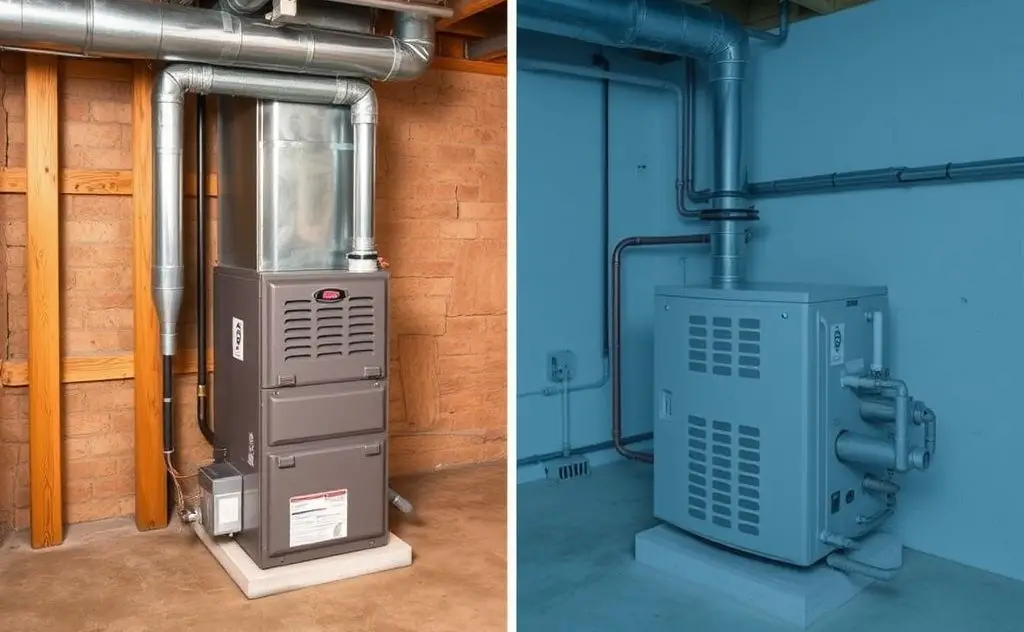HVAC refers to the entire heating, ventilation, and air conditioning system, while a furnace specifically heats air for indoor spaces.
Understanding home heating and cooling systems can be confusing for homeowners. While HVAC systems and furnaces both provide warmth, they serve different purposes in your home’s comfort system. This guide breaks down the key differences between these essential components.

What is an HVAC System?
HVAC stands for Heating, Ventilation, and Air Conditioning. It’s a complete climate control system that includes:
- Heating component (furnace or heat pump)
- Cooling component (air conditioner)
- Ventilation system (ductwork and vents)
- Air filtration system
Modern HVAC systems like built-in gas heaters provide year-round temperature control and improved air quality. The system works as a unified network to maintain your home’s comfort in all seasons.
How HVAC Systems Work
HVAC systems operate through a coordinated process:
- Thermostat detects temperature changes
- System activates heating or cooling components
- Conditioned air circulates through ductwork
- Vents distribute air throughout living spaces
- Return vents bring air back to be reconditioned

What is a Furnace?
A furnace is specifically a heating device that generates warm air for distribution. Key characteristics include:
- Single-purpose heating appliance
- Operates independently or as part of HVAC
- Available in gas, electric, or oil models
- Typically paired with air conditioner in split systems
According to U.S. Department of Energy, furnaces remain the most common heating system in American homes.
Types of Furnaces
Gas Furnaces
Use natural gas or propane combustion to generate heat. They feature:
- Burners for fuel combustion
- Heat exchangers to transfer warmth
- Flue for exhaust gases
Electric Furnaces
Use heating elements similar to electric heaters to warm air. Benefits include:
- No combustion or exhaust requirements
- Quieter operation
- Easier installation
Key Differences Between HVAC and Furnace
| Feature | HVAC System | Furnace |
|---|---|---|
| Function | Heating, cooling, and ventilation | Heating only |
| Components | Furnace, AC, ductwork, thermostat | Burners, heat exchanger, blower |
| Seasonal Use | Year-round | Primarily winter |
| Installation | Complex, whole-home system | Can be standalone |
Maintenance Considerations
Proper maintenance differs between complete HVAC systems and standalone furnaces:
HVAC Maintenance
- Seasonal inspections for both heating and cooling
- Duct cleaning every 3-5 years
- Filter changes every 1-3 months
- Refrigerant level checks
Furnace Maintenance
- Annual pre-winter inspection
- Burner cleaning
- Heat exchanger inspection
- Blower motor lubrication
The Air Conditioning, Heating and Refrigeration Institute provides comprehensive checklists for both system types.
Choosing Between HVAC and Furnace
Consider these factors when deciding on your home’s system:
- Climate: HVAC provides better value in regions with both hot summers and cold winters
- Home size: Larger homes benefit from integrated HVAC systems
- Existing infrastructure: Ductwork may determine your options
- Energy efficiency: Modern HVAC systems often exceed furnace efficiency
- Budget: Furnaces alone cost less than complete HVAC systems
For specialized heating needs, products like indoor propane space heaters can supplement either system.

